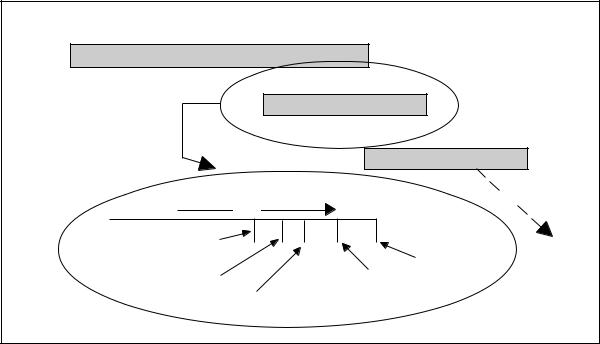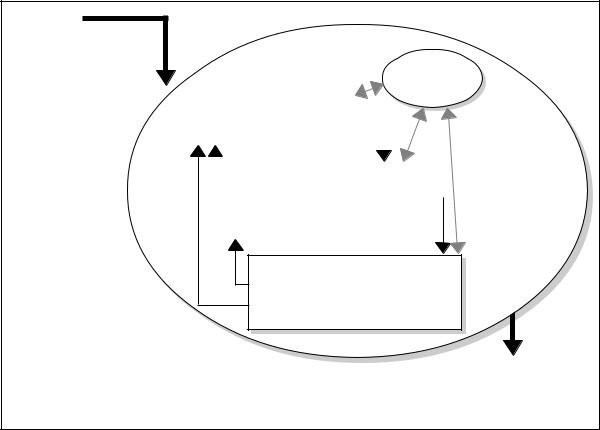
Диплом ИМЭ, ССК / Диплом / diplom / Приложения / HANDBOOK_DOD-Systems-Engineering-Guide-2001-01
.pdf
Chapter 2 |
Systems Engineering Management in DoD Acquisition |
A |
B |
C |
|
|
|
Core |
|
|
|
|
|
B |
C |
|
|
|
|
Block A |
|
|
|
|
B |
C |
|
|
|
|
Block B |
|
|
Block A |
|
Etc. |
|
|
P3I |
|
|
|
|
|
|
|
|
First Block A Release |
|
|
|
|
(Related to Block A IOC) |
|
Final Block A |
|
|
|
|
Release |
|
|
Release 2 |
|
Release |
|
|
|
(Related to P3I) |
|
|
|
|
Release 3 |
|
|
|
|
|
|
|
Figure 2-9. Incremental Release Within Evolutionary Blocks
Planning
Evolutionary acquisition program planning must clearly define how the core and evolutionary blocks will be structured, including:
1.A clear description of an operationally suitable core system including identification of subsystems and components most likely to evolve.
2.Establishment of a process for obtaining, evaluating and integrating operational feedback, technology advancements, and emerging commercial products.
3.Planning for evolutionary block upgrade evaluation, requirements validation, and program initiation.
4.Description of the management approach for evolutionary upgrades within a block and the constraints and controls associated with incremental delivery of capability.
5.Risk analysis of the developmental approach, both technical and managerial.
Systems engineering planning should emphasize:
1.The openness and modularity of the design of the core system architecture in order to facilitate modification and upgrades,
2.How baseline documentation is structured to improve flexibility for upgrade,
3.How evolutionary acquisition planning impacts baseline development and documentation control,
4.How technical reviews will be structured to best support the acquisition decision points, and
5.How risk management will monitor and control the management and technical complexity introduced by evolutionary development.
The basic system architecture should be designed to accommodate change. Techniques such as open architecting, functional partitioning, modular design, and open system design (all described later in this book) are key to planning for a flexible system that can be easily and affordably modified.
27
Systems Engineering Fundamentals |
|
|
|
Chapter 2 |
|
|
|
|
|
|
|
|
Notional Example of Evolutionary MAIS Acquisition Relationships |
|
|||
|
|
|
|
|
|
|
System Level |
Acquisition |
Acquisition |
|
|
Characterization |
Program |
Documentation |
Baseline |
CM Authority |
|
|
|
Level |
Required |
|
|
|
|
|
|
|
|
Overall Need |
Major Program |
Capstone or |
Capstone |
Top Level |
PMO |
|
or |
Sub-Portfolio |
Acquisition |
Functional |
|
|
Business Area |
|
Documentaion |
Baseline |
|
|
|
|
|
|
|
Core and |
Build or Block |
Acquisition |
Full |
Cumulative |
PMO with |
Evolutionary |
of |
Program |
Program |
Functional and |
Contractor |
Blocks |
Major Program |
|
Documentation |
Allocated |
Support |
|
|
|
|
Baseline |
|
|
|
|
|
|
|
Incremental |
Release or |
Internal to |
Separate |
Product |
Contractor |
Delivery of |
Version |
Acquisition |
Acquisition |
Baseline |
(Must Meet |
Capability |
of Block |
Program |
Documentation |
|
Allocated |
|
|
|
Not Required |
|
Basleine) |
|
|
|
|
|
|
Associated |
Application |
Parallel Product |
Component or |
Functional, |
PMO/Contractor |
Product |
or |
Improvement |
Lower Decision |
Allocated, and |
|
Improvements |
Bridge |
(Less than MAIS) |
Level Acquisition |
Product Baselines |
|
|
|
|
Processing |
|
|
|
|
|
|
|
|
Table 2-1. Evolutionary Acquisition Relationships
Example |
Summary |
Table 2-1 illustrates some of the relationships discussed above as it might apply to a Major Automated Information System (MAIS) program. Due to the nature of complex software development, a MAIS acquisition inevitably will be an evolutionary acquisition. In the notional MAIS shown in the table, management control is primarily defined for capstone, program, subsystem or incremental delivery, and supporting program levels. The table provides relationships showing how key acquisition and system engineering activities correlate in the evolutionary environment. Probably the most important lesson of Table 2-1 is that these relationships are complex and if they are not planned for properly, they will present a significant risk to the program.
Acquisition oversight is directly related to the performance, cost, and schedule defined in the acquisition baseline. It establishes the approved scope of the developmental effort. Evolutionary development that exceeds the boundaries established by the acquisition baseline requires a new or revised acquisition review process with additional oversight requirements. The development and approval of the ORD and Acquisition Program Baseline are key activities that must structure an evolutionary process that provides user and oversight needs, budgetary control, requirements traceability, risk mitigation, and configuration management.
28

Chapter 3 |
Systems Engineering Process Overview |
PART 2
THE
SYSTEMS
ENGINEERING
PROCESS
29
Systems Engineering Fundamentals |
Chapter 3 |
30

Chapter 3 |
Systems Engineering Process Overview |
CHAPTER 3
SYSTEMS ENGINEERING
PROCESS OVERVIEW
3.1 THE PROCESS
The Systems Engineering Process (SEP) is a comprehensive, iterative and recursive problem solving process, applied sequentially top-down by integrated teams. It transforms needs and requirements into a set of system product and process descriptions, generate information for decision makers, and provides input for the next level of development. The process is applied sequentially, one level at a time, adding additional detail and
definition with each level of development. As shown by Figure 3-1, the process includes: inputs and outputs; requirements analysis; functional analysis and allocation; requirements loop; synthesis; design loop; verification; and system analysis and control.
Systems Engineering Process Inputs
Inputs consist primarily of the customer’s needs, objectives, requirements and project constraints.
Process Input
•Customer Needs/Objectives/ Requirements
–Missions
–Measures of Effectiveness
–Environments
–Constraints
•Technology Base
•Output Requirements from Prior Development Effort
•Program Decision Requirements
•Requirements Applied Through Specifications and Standards
|
|
|
|
|
|
|
System Analysis |
||||||
|
|
|
|
Requirements Analysis |
|
|
|
and Control |
|
||||
|
|
|
|
|
|
|
(Balance) |
|
|
||||
|
• Analyze Missions and Environments |
|
|
|
|
|
|||||||
|
|
|
|
|
|
|
|
|
|
||||
|
• Identify Functional Requirements |
|
|
|
|
|
|
|
|
|
|||
|
• Define/Refine Performance and Design |
|
|
|
|
|
|
|
• Trade-Off Studies |
||||
|
Constraint Requirements |
|
|
|
|
|
|
|
|||||
|
|
|
|
|
|
|
|
• |
Effectiveness Analyses |
||||
|
|
|
|
|
|
|
|
|
|
|
|
||
|
|
|
|
|
|
|
|
|
|
|
|
• |
Risk Management |
|
|
|
|
|
|
|
|
|
|
|
|
||
|
|
|
|
Requirements Loop |
|
|
|
|
|
||||
|
|
|
|
|
|
|
|
|
• |
Configuration Management |
|||
|
|
|
|
|
|
|
|
|
|||||
|
|
|
|
|
|
|
|
|
|
|
|
• |
Interface Management |
|
|
|
|
Functional Analysis/Allocation |
|
|
|
|
• |
Data Management |
|||
|
|
|
|
• Decompose to Lower-Level Functions |
|
|
|
|
• |
Perfromance Measurement |
|||
|
|
|
|
|
|
|
|
|
– SEMS |
||||
|
|
|
|
• Allocate Performance and Other Limiting Requirements |
|
|
|
|
|||||
|
|
|
|
|
|
|
|
– TPM |
|||||
|
|
|
|
to All Functional Levels |
|
|
|
|
|
||||
|
|
|
|
|
|
|
|
|
– Technical Reviews |
||||
|
|
|
|
• Define/Refine Functional Interfaces (Internal/External) |
|
|
|
|
|||||
|
|
|
|
|
|
|
|
|
|||||
|
|
|
|
• Define/Refine/Integrate Functional Architecture |
|
|
|
|
|
|
|||
|
|
|
|
|
|
|
|
|
|
|
|
|
|
|
|
|
|
|
|
|
|
|
|
|
|
|
|
Design Loop
Synthesis
•Transform Architectures (Functional to Physical)
•Define Alternative System Concepts, Configuration
Verification Items and System Elements
•Select Preferred Product and Process Solutions
•Define/Refine Physical Interfaces (Internal/External)
Related Terms: |
|
Process Output |
||
|
|
|||
Customer = |
Organizations responsible for Primary Functions |
• |
Development Level Dependent |
|
Primary Functions = Development, Production/Construction, Verification, |
||||
|
– Decision Database |
|||
|
Deployment, Operations, Support, Training, Disposal |
|
– System/Configuration Item |
|
Systems Elements = |
Hardware, Software, Personnel, Facilities, Data, Material, |
|
Architecture |
|
|
Services, Techniques |
|
– Specifications and Baselines |
|
Figure 3-1. The Systems Engineering Process
31
Systems Engineering Fundamentals |
Chapter 3 |
Inputs can include, but are not restricted to, missions, measures of effectiveness, environments, available technology base, output requirements from prior application of the systems engineering process, program decision requirements, and requirements based on “corporate knowledge.”
Requirements Analysis
The first step of the Systems Engineering Process is to analyze the process inputs. Requirements analysis is used to develop functional and performance requirements; that is, customer requirements are translated into a set of requirements that define what the system must do and how well it must perform. The systems engineer must ensure that the requirements are understandable, unambiguous, comprehensive, complete, and concise.
Requirements analysis must clarify and define functional requirements and design constraints. Functional requirements define quantity (how many), quality (how good), coverage (how far), time lines (when and how long), and availability (how often). Design constraints define those factors that limit design flexibility, such as: environmental conditions or limits; defense against internal or external threats; and contract, customer or regulatory standards.
Functional Analysis/Allocation
Functions are analyzed by decomposing higherlevel functions identified through requirements analysis into lower-level functions. The performance requirements associated with the higher level are allocated to lower functions. The result is a description of the product or item in terms of what it does logically and in terms of the performance required. This description is often called the functional architecture of the product or item. Functional analysis and allocation allows for a better understanding of what the system has to do, in what ways it can do it, and to some extent, the priorities and conflicts associated with lower-level functions. It provides information essential to optimizing physical solutions. Key tools in functional analysis and allocation are Functional Flow
Block Diagrams, Time Line Analysis, and the
Requirements Allocation Sheet.
Requirements Loop
Performance of the functional analysis and allocation results in a better understanding of the requirements and should prompt reconsideration of the requirements analysis. Each function identified should be traceable back to a requirement. This iterative process of revisiting requirements analysis as a result of functional analysis and allocation is referred to as the requirements loop.
Design Synthesis
Design synthesis is the process of defining the product or item in terms of the physical and software elements which together make up and define the item. The result is often referred to as the physical architecture. Each part must meet at least one functional requirement, and any part may support many functions. The physical architecture is the basic structure for generating the specifications and baselines.
Design Loop
Similar to the requirements loop described above, the design loop is the process of revisiting the functional architecture to verify that the physical design synthesized can perform the required functions at required levels of performance. The design loop permits reconsideration of how the system will perform its mission, and this helps optimize the synthesized design.
Verification
For each application of the system engineering process, the solution will be compared to the requirements. This part of the process is called the verification loop, or more commonly, Verification. Each requirement at each level of development must be verifiable. Baseline documentation developed during the systems engineering process must establish the method of verification for each requirement.
32
Chapter 3 |
Systems Engineering Process Overview |
Appropriate methods of verification include examination, demonstration, analysis (including modeling and simulation), and testing. Formal test and evaluation (both developmental and operational) are important contributors to the verification of systems.
Systems Analysis and Control
Systems Analysis and Control include technical management activities required to measure progress, evaluate and select alternatives, and document data and decisions. These activities apply to all steps of the sysems engineering process.
System analysis activities include trade-off studies, effectiveness analyses, and design analyses. They evaluate alternative approaches to satisfy technical requirements and program objectives, and provide a rigorous quantitative basis for selecting performance, functional, and design requirements. Tools used to provide input to analysis activities include modeling, simulation, experimentation, and test.
Control activities include risk management, configuration management, data management, and performance-based progress measurement including event-based scheduling, Technical Performance Measurement (TPM), and technical reviews.
The purpose of Systems Analysis and Control is to ensure that:
•Solution alternative decisions are made only after evaluating the impact on system effectiveness, life cycle resources, risk, and customer requirements,
•Technical decisions and specification requirements are based on systems engineering outputs,
•Traceability from systems engineering process inputs to outputs is maintained,
•Schedules for development and delivery are mutually supportive,
•Required technical disciplines are integrated into the systems engineering effort,
•Impacts of customer requirements on resulting functional and performance requirements are examined for validity, consistency, desirability, and attainability, and,
•Product and process design requirements are directly traceable to the functional and performance requirements they were designed to fulfill, and vice versa.
Systems Engineering Process Output
Process output is dependent on the level of development. It will include the decision database, the system or configuration item architecture, and the baselines, including specifications, appropriate to the phase of development. In general, it is any data that describes or controls the product configuration or the processes necessary to develop that product.
3.2 SUMMARY POINTS
•The system engineering process is the engine that drives the balanced development of system products and processes applied to each level of development, one level at a time.
•The process provides an increasing level of descriptive detail of products and processes with each system engineering process application. The output of each application is the input to the next process application.
33
Systems Engineering Fundamentals |
Chapter 3 |
34

Chapter 4 |
Requirements Analysis |
CHAPTER 4
REQUIREMENTS
ANALYSIS
4.1SYSTEMS ENGINEERING PROCESS INPUTS
The inputs to the process include the customer’s requirements and the project constraints. Requirements relate directly to the performance characteristics of the system being designed. They are the stated life-cycle customer needs and objectives for the system, and they relate to how well the system will work in its intended environment.
Constraints are conditions that exist because of limitations imposed by external interfaces, project support, technology, or life cycle support systems. Constraints bound the development teams’ design opportunities.
Requirements are the primary focus in the systems engineering process because the process’s primary purpose is to transform the requirements into designs. The process develops these designs within
the constraints. They eventually must be verified to meet both the requirements and constraints.
Types of Requirements
Requirements are categorized in several ways. The following are common categorizations of requirements that relate to technical management:
Customer Requirements: Statements of fact and assumptions that define the expectations of the system in terms of mission objectives, environment, constraints, and measures of effectiveness and suitability (MOE/MOS). The customers are those that perform the eight primary functions of systems engineering (Chapter 1), with special emphasis on the operator as the key customer. Operational requirements will define the basic need and, at a minimum, answer the questions posed in Figure 4-1.
Operational distribution or deployment: Where will the system be used?
Mission profile or scenario: How will the system accomplish its mission objective?
Performance and related parameters: What are the critical system parameters to accomplish the mission?
Utilization environments: How are the various system components to be used?
Effectiveness requirements: How effective or efficient must the system be in performing its mission?
Operational life cycle: How long will the system be in use by the user?
Environment: What environments will the system be expected to operate in an effective manner?
Figure 4-1. Operational Requirements – Basic Questions
35
Systems Engineering Fundamentals |
Chapter 4 |
Functional Requirements: The necessary task, action or activity that must be accomplished. Functional (what has to be done) requirements identified in requirements analysis will be used as the toplevel functions for functional analysis.
Performance Requirements: The extent to which a mission or function must be executed; generally measured in terms of quantity, quality, coverage, timeliness or readiness. During requirements analysis, performance (how well does it have to be done) requirements will be interactively developed across all identified functions based on system life cycle factors; and characterized in terms of the degree of certainty in their estimate, the degree of criticality to system success, and their relationship to other requirements.
Design Requirements: The “build to,” “code to,” and “buy to” requirements for products and “how to execute” requirements for processes expressed in technical data packages and technical manuals.
Derived Requirements: Requirements that are implied or transformed from higher-level requirement. For example, a requirement for long range or high speed may result in a design requirement for low weight.
Allocated Requirements: A requirement that is established by dividing or otherwise allocating a high-level requirement into multiple lower-level requirements. Example: A 100-pound item that consists of two subsystems might result in weight requirements of 70 pounds and 30 pounds for the two lower-level items.
Attributes of Good Requirements
The attributes of good requirements include the following:
•A requirement must be achievable. It must reflect need or objective for which a solution is technically achievable at costs considered affordable.
•It must be verifiable—that is, not defined by words such as excessive, sufficient, resistant, etc. The expected performance and functional utility must be expressed in a manner that allows verification to be objective, preferably quantitative.
•A requirement must be unambiguous. It must have but one possible meaning.
•It must be complete and contain all mission profiles, operational and maintenance concepts, utilization environments and constraints. All information necessary to understand the customer’s need must be there.
•It must be expressed in terms of need, not solution; that is, it should address the “why” and “what” of the need, not how to do it.
•It must be consistent with other requirements. Conflicts must be resolved up front.
•It must be appropriate for the level of system hierarchy. It should not be too detailed that it constrains solutions for the current level of design. For example, detailed requirements relating to components would not normally be in a system-level specification.
4.2 REQUIREMENTS ANALYSIS
Requirements analysis involves defining customer needs and objectives in the context of planned customer use, environments, and identified system characteristics to determine requirements for system functions. Prior analyses are reviewed and updated, refining mission and environment definitions to support system definition.
Requirements analysis is conducted iteratively with functional analysis to optimize performance requirements for identified functions, and to verify that synthesized solutions can satisfy customer requirements. The purpose of Requirements Analysis is to:
36
